The Purple Aster Wildflower brings lovely perky pops of purple to the fall landscape, delightful for pollinators and for people!
We enjoy seeing the purple aster wildflowers in the woodland roadside on our daily dog walks, for its vibrant hues and delicate petals, and bright yellow-orange centers. Beyond the wildflowers, the Purple Aster is a captivating sight in yard and garden landscapes as well.
Beyond beauty, these wildflowers are not only a visual treat but also provide pollinators important late season nutrients, as well as edible and medicinal benefits according to Native American ethnobotany.
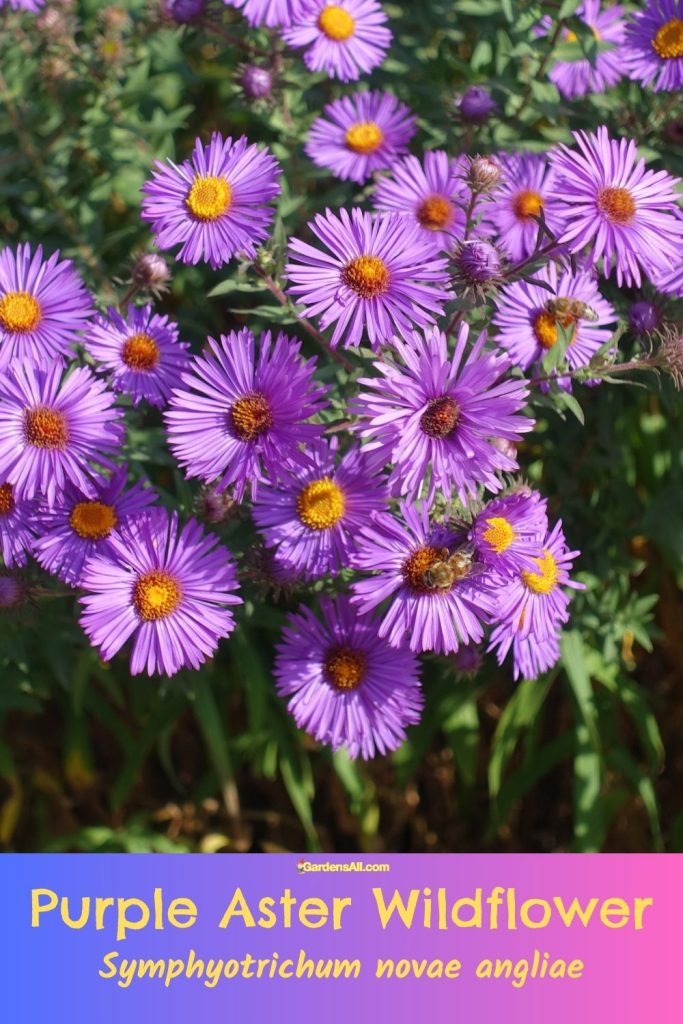
Getting to Know Purple Aster Wildflowers
Purple Aster Names
- Scientific Name: Symphyotrichum novae-angliae
- Common Names: New England Aster, Michaelmas Daisy, Purple Dome Cone
Hardiness and Habitat of Purple Aster Wildflower
- Hardiness Zones: 4-8
- Regions Found: Found throughout the eastern and central parts of the United States
- Habitat: Prairies, meadows, roadsides and near streams.
Growing Information for Purple Aster Wildflower
- Life Cycle: Perennial
- Soil: Prefers rich and well-draining soils but can also grow in clay and other nutritional depleted soil.
- Sun: Prefers full sun but can grow in partial shade, however may be sparse and leggy.
- Invasive: Not invasive
- Bloom Time: Late summer to early fall; typically August to October, depending on zone
- Fragrance: No; these flowers are not known for their fragrance
See more purple flowers that bloom in fall.
Uses and Benefits of Purple Aster
- Edible parts: The aster plant can be nibbled from the plant, tossed fresh into salads, or dried for teas, salves and tinctures.
- Medicinal uses or benefits: Historically, Native American tribes used purple aster wildflowers for various medicinal purposes, including treating fevers, coughs, digestive issues, and poultices for various skin conditions.[1]https://plants.usda.gov/DocumentLibrary/plantguide/pdf/pg_syno2.pdf
- Wildlife: Beneficial fall bloomer for pollinators
See our article on Calico Aster, and also the reference list at the bottom of this article for more on the ethnobotanical benefits of Purple Aster, and more on pollinator flowers here.
Purple Aster Wildflower Description
- Plant Size & Appearance: 3-6 feet tall bushy plant with multiple stems that can become woody at the base.
- Blossom Size & Appearance: Daisy-like, with numerous slender purple to pinkish-purple ray petals surrounding a central yellow disk. Each blossom measures about 1-1.5 inches in diameter.
- Leaf Size & Shape Description: The leaves are lanceolate (lance-shaped) measuring up to 4 inches in length. They are alternately arranged on the stems and have a rough texture with smooth edges.
The New England Aster, with its rich purple petals and contrasting yellow center, is a favorite among gardeners and nature enthusiasts alike. Its ability to thrive in various conditions and its late-season blooms make it a valuable addition to any yard and garden landscape.
This wildflower is often lanky and sprawly. For more bushy clusters or the New England Purple Aster, check out our article on Purple Dome Aster, a cultivar of its wild cousin.
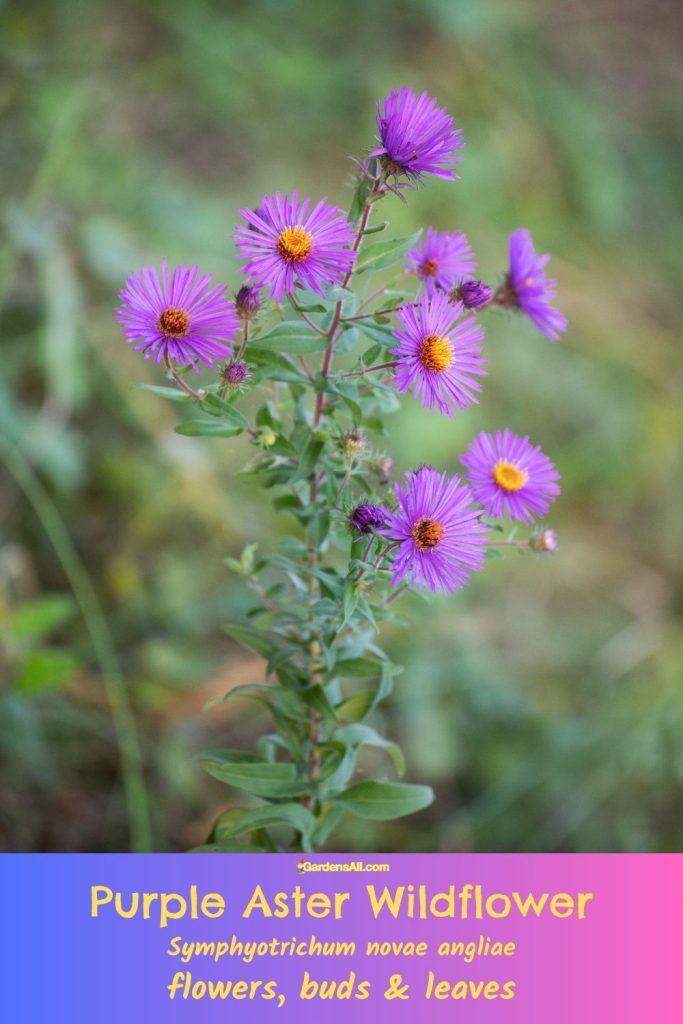
Purple Aster Taxonomy
- Kingdom: Plantae
- Division (or Phylum): Magnoliophyta
- Class: Magnoliopsida
- Order: Asterales
- Family: Asteraceae
- Genus: Symphyotrichum
- Species: S. novae-angliae
- Genus: Symphyotrichum
- Family: Asteraceae
- Order: Asterales
- Class: Magnoliopsida
- Division (or Phylum): Magnoliophyta
The species name “novae-angliae” is Latin in origin and translates to “of New England.” This is a reference to the region where the New England Aster, or Symphyotrichum novae-angliae, is native and most commonly found.
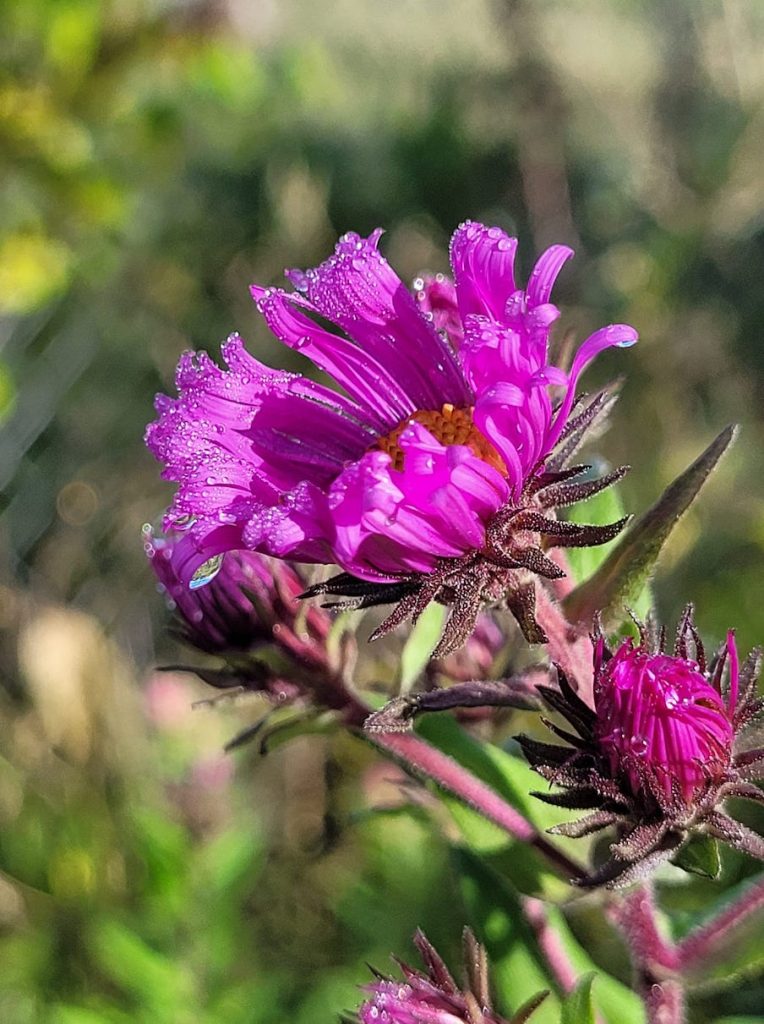
Purple Aster Wildflower Pollinator Benefits
Asters, in general, are known to be important for pollinators, providing nectar and pollen in the late season when many other flowers have ceased blooming. Different species of asters might attract slightly different pollinator communities based on their specific characteristics, such as flower size, color, or bloom time.
The availability and activity of pollinators can vary based on the specific region and the conditions of a given year. However, in general, Asters enjoy visits by the following beneficial pollinators in fall.
Pollinators:
- Bees: Many species of bees, including honeybees and bumblebees, are still active in the fall and seek out nectar and pollen sources. Bumblebee queens that will overwinter and start new colonies the following spring are especially in need of food to build up reserves. However, as temperatures drop, their activity can decrease.
- Butterflies: Some butterflies, like the Monarch, are migratory and rely on late-season nectar sources to fuel their journey south. Others might be winding down their activity, but still, seek out nectar on warmer fall days.
- Moths: The activity of moths can be quite varied. Some species of moths are indeed active in the fall and will seek out nectar sources. However, many moth species are more active in the spring and summer.
- Hoverflies: Hoverflies, or syrphid flies, can be seen on warm fall days, especially in early to mid-fall. Their activity decreases as temperatures drop.
- Beetles: The activity of beetles can vary widely based on the species. Some might still be active in the early fall, while others may have already completed their life cycle for the year.
The presence of Asters in a garden or landscape can significantly enhance its value for pollinators, especially in the late season. By providing a continuous food source from spring through fall, gardens can support a diverse and healthy pollinator population.
Video on Purple Asters Buzzing With Bees
Thanks to Rachelle Zackus for sharing her video with us. Expand it to see all the bees buzzing around these fall flowers in Montana around the first of October, 2023.
Last Days of Faded Flowers – Still Attractive to Bees!
The flowers in this photo were more vibrantly purple last week, but the bees are still loving them! Here’s you see flowers, bud and spent blossom, plus a little bit of the lanceolata shaped leaves.
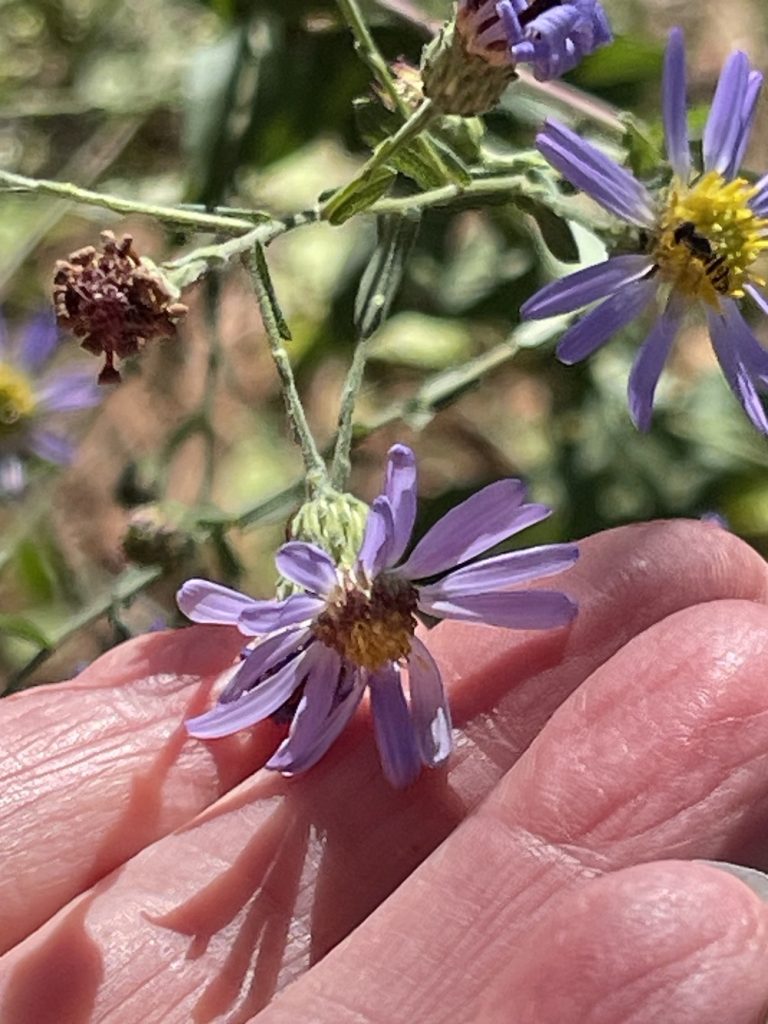
Video on Bumblebee on Purple Aster Wildflowers in Fall
We captured this on one of our daily dog-walks around our wooded neighborhood… added an uplifting tune, and it’s a quick 1:11 minutes of delightful❣️
Where Does Symphyotrichum novea-angliae Grow?
Native to North America, the Purple Aster Wildflower, has been introduced to other parts of the world, primarily as an ornamental plant.
- Europe: The New England Aster has been cultivated in European gardens for many years and has naturalized in some areas. It can be found in countries like the UK, Germany, and France, among others.
- Asia: While not as common, the New England Aster has been introduced to some Asian countries, primarily in gardens.
- Australia: The plant has also been introduced to Australia, where it is grown as an ornamental.
Symphyotrichum novae-angliae is not widely recognized as an invasive species in regions outside of its native range. However, the status of plants can change over time as more research is conducted and as ecological conditions evolve. It’s always a good idea to check with local environmental or agricultural agencies when considering planting non-native species
Ethnobotanical Information on
Ethnobotany and ethnopharmacology study the relationships between plants and people, particularly the traditional uses of plants for medicinal, cultural, and other purposes. While Symphyotrichum novae-angliae (New England Aster) has been traditionally used in various cultures, specific references to the ‘Purple Dome’ cultivar in this context might be limited since it’s a cultivated variety.
Here are some resources that delve into the ethnobotanical or ethnopharmacological benefits of the New England Aster and related species:
- Books:
- “Native American Ethnobotany” by Daniel E. Moerman: This comprehensive tome provides detailed information on the traditional uses of North American plants by indigenous peoples, including various Aster species.
- “Medicinal Plants of North America: A Field Guide” by Jim Meuninck: This field guide covers many plants native to North America and their traditional medicinal uses.
- Research Journals:
- Journal of Ethnopharmacology: This peer-reviewed journal publishes articles related to the traditional medicinal use of plants. While specific articles on New England Aster might be limited, broader searches on the Asteraceae family or related species might yield relevant information.[2]https://www.sciencedirect.com/science/article/pii/S0031942211001178#s0010
- Local and Indigenous Knowledge:
- Engaging with local herbalists, indigenous communities, or elders can provide interesting and useful firsthand knowledge on the traditional uses of plants.
References
Ethnobotany: Meaning, Medicine and the ‘Placebo Effect’ (Cambridge Studies in Medical Anthropology Book 9) 1st Edition, Kindle Edition, by Daniel E. Moerman
Corrected Reference
NOTE: Many sources say that asters are rabbit proof, based on a paper published in 1990:
Dr. David H. Thomas, botanist and professor at the University of Wales, Aberystwyth published several papers and books on plant ecology, physiology, and taxonomy, especially on the genus Saxifraga. One of his papers is titled “The Ecology and Distribution of Saxifrages”, in 1990 in the journal Botanical Journal of Scotland [3]https://www.nationalgeographic.org/article/how-european-rabbits-took-over-australia.
This paper contains an oft-cited and repeated statement: “Most species in this genus seem to be immune to the predations of rabbits (Thomas 1990).”
However, there are more recent observations that rabbits may indeed consume Asters, such an article footnoted here by Maryland Department of Natural Resources, titled ‘Native Plant Profile: New England Aster (Symphyotrichum novae-angliae)’.[4]https://news.maryland.gov/dnr/2019/10/18/native-plant-profile-new-england-aster-symphyotrichum-novae-angliae/#:~:text=A%20number%20of%20moth%20species,white%2Dtailed%20deer%20and%20rabbits.
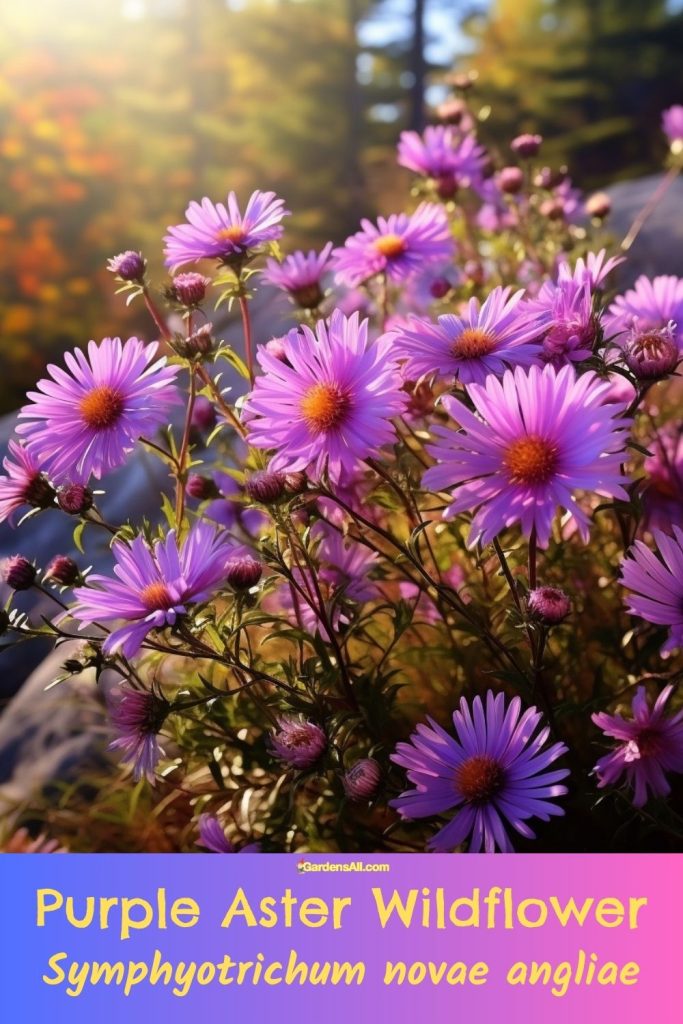
Video on Wild Aster Foraging
I’m LeAura Alderson, a garden, herb and plant enthusiast with a passion for discovering the many edible and medicinal benefits of the plants all around us, including the weeds! I’m a writer, editor and media publisher for our family of websites.
While I was certified in fitness and life coaching, I am NOT a health practitioner. However, I’m a lifelong health enthusiast, with a keen interest in healthy, organic foods and making home remedies and the content we share is from our own experience and usage as well as that extracted from scientific research so that you can explore further on your own.
Always seek the advice and guidance of your health practitioners first and foremost.
As a family we’re steadily expanding our gardening, experimentation and knowledge around all things gardening, edible landscaping, fresh organic foods and self sustainability with farming in our future. I also own and manage iCreateDaily.com, a site all about transformation through creation, and the power of positivity, optimism and mindset.
References

